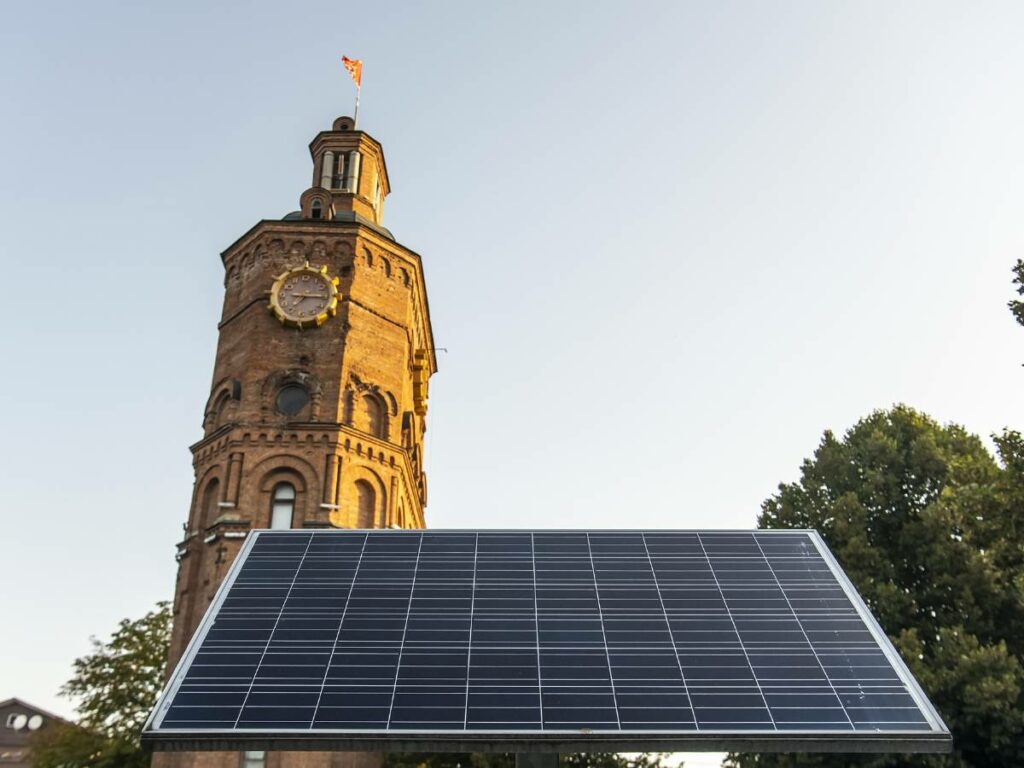Solar panels have become a prominent symbol of renewable energy and are vital to our transition toward sustainable power sources. It is important to learn about the history of solar panels.
Solar panels are also known as photovoltaic (PV) panels. This turns sunlight into electricity using the photovoltaic effect. They comprise interconnected solar cells, typically composed of silicon or other semiconductor materials, which absorb photons from sunlight and generate an electric current. This direct conversion of the sun into electricity makes solar panels an environmentally friendly alternative to fossil fuels.
Solar energy has gained immense significance in our modern world for several reasons. It is a renewable energy source that is virtually inexhaustible. Solar energy offers environmental benefits.
It also provides energy independence and resilience. Solar energy has significant economic potential. The declining costs of solar panels, coupled with advancements in technology and government incentives, have made solar power increasingly competitive with traditional energy sources.
Early Developments
The photovoltaic effect, the phenomenon of generating electricity from light, was first discovered by French physicist Alexandre-Edmond Becquerel in 1839, who observed the production of an electric current when certain materials were exposed to sunlight.
In the late 19th Century, Charles Fritts conducted the first experiments with solar energy by developing the first working selenium solar cell in 1883. This cell, made of a thin layer of selenium on a metal plate, was the earliest practical application of converting sunlight directly into electricity.
Advancements in the 20th Century
In 1905, Albert Einstein published his groundbreaking work on the photoelectric effect, providing a theoretical explanation for how light can cause the emission of electrons from a material’s surface. His discoveries laid the foundation for understanding the interaction between light and matter, eventually leading to advancements in solar cell technology.
In the 1950s and 1960s, researchers at various institutions, including Bell Labs and IBM, made significant progress in developing silicon-based solar cells. Silicon, a semiconductor material, proved to be highly efficient at converting sunlight into electricity, and these early silicon solar cells set the stage for further improvements in solar panel technology.
In 1954, researchers at Bell Labs, led by Daryl Chapin, Gerald Pearson, and Calvin Fuller, achieved a significant breakthrough by creating the first practical silicon solar cell. This has a conversion efficiency of 6%. The achievement marked a milestone in the development of solar panels and paved the way for their commercialization.
In the late 1950s and throughout the 1960s, solar panels found their first practical application in space exploration. Solar panels were used to power satellites and spacecraft, providing a reliable and sustainable source of electricity in the harsh conditions of outer space.
During the same period, solar panels were also employed in remote areas and off-grid locations where connecting to conventional power grids was impractical. Solar panels provide a cost-effective solution for generating electricity in rural communities, weather stations, and telecommunications infrastructure, enabling greater energy independence and access to power.
Growth and Commercialization

Over the years, significant advancements in solar panel technology have led to increased efficiency and decreased costs. Researchers and engineers have continuously improved the design and manufacturing processes, leading to higher conversion efficiencies and making solar panels more economically viable as mainstream energy source.
Governments worldwide have recognized solar energy’s importance and implemented various support mechanisms and incentives to encourage its adoption. These include feed-in tariffs, tax credits, grants, and subsidies.
With the increasing demand and favorable policies, the solar panel industry has experienced significant expansion. Manufacturers have scaled production, leading to economies of scale and further cost reductions. The industry has witnessed a rise in competition, innovation, and research and development efforts, resulting in improved solar panel efficiency, durability, and aesthetics.
As solar panels became, more efficient and affordable, large-scale solar power plants emerged as a viable and sustainable source of electricity generation. These solar farms consist of thousands or even millions of solar panels, often installed in sunny regions or on large open spaces, capable of generating significant amounts of electricity that can be fed into the grid to meet the energy needs of communities and industries.
Technological Innovations
Thin-film solar cells: Thin-film solar cells represent a technological innovation in solar panel design. These cells are made by depositing a thin layer of semiconductor material onto a substrate, such as glass or flexible plastic.
Multi-junction solar cells: Multi-junction solar cells are designed to maximize solar energy conversion by utilizing multiple layers of semiconductors with varying band gaps. Each layer is optimized to absorb a specific portion of the solar spectrum, allowing higher efficiency.
Concentrated solar power: Concentrated solar power (CSP) systems employ mirrors or lenses to focus sunlight onto a receiver. It also absorbs concentrated energy and converts it into heat.
Perovskite solar cells: Perovskite solar cells are becoming popular in recent years due to their high-efficiency potential and ease of manufacturing. These cells use a perovskite-structured material, typically a hybrid organic-inorganic lead halide, as the light-absorbing layer.
Global Impact
Renewable energy transition: Solar panels are crucial in the global shift towards renewable energy sources. As one of the fastest-growing renewable energy technologies, solar power has the potential to reduce dependence on fossil fuels. It also mitigates climate change significantly.
Environmental benefits of solar panels: Solar panels offer numerous environmental benefits. Firstly, they generate electricity without emitting greenhouse gases, helping to combat air pollution and reduce carbon emissions. Secondly, solar power reduces the reliance on finite fossil fuel resources, conserving them for future generations. Lastly, solar energy reduces the need for land disruption associated with traditional energy extraction, such as mining or drilling.
Solar power in developing countries: Solar panels have had a transformative impact in developing countries, particularly in regions with limited access to electricity. Solar energy provides a decentralized and scalable solution, enabling communities to leapfrog traditional energy infrastructure and access clean, reliable electricity.
Integration with energy storage: Integrating solar panels with energy storage technologies, such as batteries, enhances the reliability and flexibility of solar power systems. Energy storage enables the capture and storage of excess solar energy during peak production periods.
Future Prospects

The future holds great potential for further advancements in solar panel technology. Ongoing research focuses on increasing the efficiency of solar cells, exploring new materials and designs, and developing innovative manufacturing techniques.
Solar energy has the potential for widespread adoption across residential, commercial, and industrial sectors. As solar panel costs decline and efficiency improves, solar power becomes increasingly competitive with traditional energy sources.
Despite the progress made, several challenges and areas for improvement remain. It stores solar energy to address intermittency. It enhances the durability and longevity of solar panels. This reduces manufacturing processes’ environmental impact and improves end-of-life panels’ recycling techniques.
Solar energy plays a crucial role in mitigating climate change. Solar power significantly reduces greenhouse gas emissions compared to fossil fuel-based energy generation.
Importance of Solar Energy in a Sustainable Future
Solar energy can shape a sustainable future. Solar power offers numerous benefits as a clean, renewable, and abundant energy source. It reduces greenhouse gas emissions, mitigates climate change, improves air quality, conserves natural resources, and enhances energy security.
The continued research and development of solar energy technologies can unlock its full potential. Encouraging innovation in solar panel efficiency, energy storage, materials, manufacturing techniques, and grid integration will drive progress in the field.
Further investment in research and development will lead to even more incredible advancements. This makes solar energy an increasingly viable and impactful solution in our pursuit of a sustainable future.


